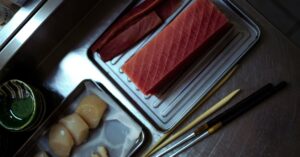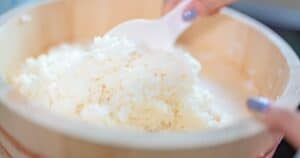Ever wonder why that pile of thin pink slices is on your sushi platter? If you’ve asked “Why is sushi ginger pink?” you’re not alone. The vibrant color might seem odd for a garnish, but there’s a fascinating reason behind it.
The pink hue in sushi ginger, also called gari, comes from natural pigments in young ginger roots that intensify during the pickling process. Some manufacturers also use artificial dyes or beet juice to give mature white ginger the signature pink tint. While the shades can vary, the color itself has little impact on the gingery burst of flavor.
In this article, we’ll explore the science and history behind sushi ginger’s rosy color. You’ll learn why pink emerged as the standard, how modern gari is made, and even touch on regional variations in hue. So grab your chopsticks and dive in to uncover the secrets behind this colorful accompaniment!
The Natural Source of the Pink Pigment
Unlike the mature ginger you find in the produce aisle, the ginger used for sushi ginger (also called gari or amazu shōga) is harvested when the roots are young and tender. This type of ginger naturally contains higher levels of gingerol, the compound responsible for ginger’s pungency.
Young ginger also has a greater concentration of anthocyanins, which are antioxidants that give fruits and vegetables red, blue, and purple hues. It’s these natural pinkish-purple anthocyanins that provide the base color for sushi ginger.
Harvesters look for roots that are about 5-6 months old in mid-summer when anthocyanin levels peak. The younger, the better to achieve that pretty pink gari.
The Pickling Process Intensifies the Color
On its own, the young ginger root appears beige or very light pink. To coax out that vibrant rosy color, the ginger must go through a pickling process.
The harvesting season for gari aligns with the summer months because the ginger needs several weeks to pickle. Once harvested, the ginger is peeled, julienned, and soaked in a brine of rice vinegar, salt, and sugar.
As the ginger soaks up this sweet vinegar blend, a chemical reaction occurs that causes the anthocyanins to become even more concentrated. This amplifies and stabilizes the pink hue.
The brine also pulls moisture from the ginger, causing it to curl into those familiar pink wisps. After 3-4 weeks in the pickling solution, the gari emerges infused with flavor and decked out in its signature pink.
Why Pink Became the Standard
As tasty as it is visually appealing, the pink color of gari is no accident. So why did pink become the universally recognized tone for sushi ginger?
In ancient times, ginger served with sushi was untreated, appearing beige or light yellow. But in the Edo period (1603-1868), vendors pickled ginger not just for flavor but for visual appeal.
They discovered younger roots and an aristocrat’s pink-dyed vinegar produced the most vibrant results. Pink gari became a mark of prestige offered by high-end Edo sushi establishments.
When sushi became mainstream fare in the 19th century, pink gari was established as the standard. Today, the rosy hue signals freshness and authenticity.
Modern Methods for Pink Ginger
As the demand for gari grew, suppliers got creative with achieving the desired pink tone year-round. contemporarily, most gari is made from mature ginger that lacks natural pink pigment.
To compensate, some pickle ginger in beet juice or use artificial dye to stain the gari pink. E124, also called New Coccine, is a common ginger coloring approved for use in Japan and the US.
However, high-end gari producers still use young ginger harvested in summer when anthocyanins are highest. This yields the most natural, elegant shade of pink.
Regional Variations in Color Exist
While pink may reign supreme, not all gari is colored this way. Regional variations reveal a rainbow of pickled ginger possibilities.
In Okinawa, gari features distinctive hues like yellow, mint green, and even neon blue. These bright colors come from local turmeric, spirulina, and gardenia fruits used in the pickling process.
Beni shoga, another common pickled ginger, appears red rather than pink. It’s pickled in plum vinegar called umezu, which draws out red hues from the ginger.
So while we may think of gari as quintessentially pink, there’s room for variation when it comes to coloring this palate cleanser.
The Color is Not Crucial for Flavor
While vibrant pink has become the visual marker for gari, the truth is ginger can be pickled into a stellar palate cleanser regardless of color.
The keys are using young, tender ginger and allowing time for a thorough pickling process to impart tang, sweetness, and heat. The color itself is just aesthetic.
In fact, pickled ginger can still refresh your mouth even when dyed other hues like yellow, green, or red.
So don’t be afraid to sample gari from different regions or homemade versions that may not be true pink. The flavor impact matters far more than the color!
Enjoy Gari with All Types of Sushi
However it’s colored, be sure to take a taste of pickled ginger between bites of sushi. The ping of acidity and heat scrub your palate, preparing it for the next morsel.
Gari’s cleansing effect works beautifully with fatty fish like salmon and tuna. It also complements rolls filled with shrimp tempura or creamy avocado.
Don’t limit gari to just nigiri and basic rolls either. Let it enhance specialty rolls, hand rolls, and aburi nigiri too.
Part of the art of sushi is learning how gari interacts with different fillings. Don’t be afraid to request extra of this flavor-boosting pink pickle!
So next time you enjoy sushi, take a moment to appreciate the aromatic snap of the gari. Its pretty pink color is just the first hint of this versatile Japanese delicacy.





